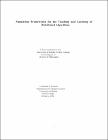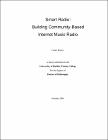Browsing Computer Science (PhD Theses) by Title
Now showing items 211-230 of 290
-
Reactive execution-time forecasting of dynamically-adaptable software
(Trinity College (Dublin, Ireland). School of Computer Science & Statistics, 2011)Software operating in domains such as process management systems, wireless sensor networks and spacecraft control systems are expected to continue uninterrupted operation over extended periods, without any manual supervision, ... -
Real-time medium access control in vehicular ad hoc networks
(Trinity College (Dublin, Ireland). School of Computer Science & Statistics, 2013)The need to reduce the number of fatalities due to road traffic accidents as well as to improve the comfort and efficiency of travel has motivated the vision of vehicular ad hoc networks. Vehicles are envisaged to be able ... -
Realistic crowd animation : a perceptual approach
(Trinity College (Dublin, Ireland). School of Computer Science & Statistics, 2006)Real-time applications such as games or urban simulations arc often highly complex in nature. User expectations grow year by year, along with a concomitant desire for added realism. Due to the performance limitations of ... -
Reducing overfitting in wrapper-based search
(Trinity College (Dublin, Ireland). School of Computer Science & Statistics, 2006)The benefits of wrapper-based techniques for feature selection are well established. However, it is acknowledged that overfitting can occur in feature selection using the wrapper method when there is a limited amount of ... -
Responsive aggregate defence for denial of service attacks
(Trinity College (Dublin, Ireland). School of Computer Science & Statistics, 2011)The Internet is the main provider of information, communication and media services for an increasing percentage of the world's population. Its architecture is based on packet switching principles and employs a layered, ... -
Risk perceptions on social networking sites : an investigation of age and other factors
(Trinity College (Dublin, Ireland). School of Computer Science & Statistics, 2012)Since the mid 2000’s, social networking sites (SNSs) such as Facebook and Bebo have seen phenomenal growth. These sites provide many benefits for users, but there are risks in using them. To date most of the studies that ... -
Saliency determination for computer graphics : an experimental approach
(Trinity College (Dublin, Ireland). School of Computer Science & Statistics, 2006)In the computer graphics realm complex objects are abundant, but often need to be simplified in order to be displayed interactively. As the human visual system is far from flawless, advantage can be taken of its weaknesses ... -
Sample identification and tracking in biobanks
(Trinity College (Dublin, Ireland). School of Computer Science & Statistics, 2010)Biobanks or bio-repositories facilitate the storage and maintenance of biological samples and data to support discovery of biomarkers, therapeutic targets, and the underlying causes of diseases. Such discoveries require ... -
Secure group communications in emergency ad hoc networks
(Trinity College (Dublin, Ireland). School of Computer Science & Statistics, 2006)Ad Hoc networks are an ideal way to form interactions between mobile wireless nodes of emergency services from different domains (i.e. organizations or countries). However, due to the frequent topological and membership ... -
Self-organizing resource location and discovery
(Trinity College (Dublin, Ireland). School of Computer Science & Statistics, 2005)Networked applications were originally centered around backbone interhost communication. Over time, communications moved to a client-server model, where inter-host communication was used mainly for routing purposes. As ... -
Self-organizing topology adaptation in peer-to-peer networks
(Trinity College (Dublin, Ireland). School of Computer Science & Statistics, 2007)The peers in a Peer-to-Peer (P2P) system arrange themselves in a virtual network called the overlay network. The overlay network sits above the underlying physical network and is used to search for resources and peers, ... -
A Semantic framework for deterministic functional input/output
(University of Dublin, Trinity College. School of Computer Science and Statistics, 2006-03)This dissertation presents a pure functional language called Curio. This language is unusual in possessing a rigorous yet general semantics for I/O which permits both formal proofs and a fine-tuned approach to concurrency. ... -
Semantic-based service analysis and optimization
(Trinity College (Dublin, Ireland). School of Computer Science & Statistics, 2013)The need to autonomically optimize end user service experience in near real time has been identified in the literature in recent years. Service management systems that monitor end user service session context are deployed ... -
Semantic-oriented cross-lingual ontology mapping
(Trinity College (Dublin, Ireland). School of Computer Science & Statistics, 2011)Ontologies support knowledge discovery, sharing and reuse among people and enable semantic interoperability between computer-based systems. To establish correspondences between knowledge concepts represented in ontologies, ... -
Service management in dynamic e-business environments
(Trinity College (Dublin, Ireland). School of Computer Science & Statistics, 2006)Internet technologies are facilitating the development of an environment where companies are outsourcing activities that are not a part of their core competencies to third-party service providers. Customers and service ... -
Simulation Frameworks for the Teaching and Learning of Distributed Algorithms
(University of Dublin, Trinity College. Department of Computer Science, 2006-02)Teaching and learning about distributed algorithms is difficult. This is because distributed algorithms are made up of multiple independent elements, each with their own state and control, who interact through the exchange ... -
Situation-based testing for ubiquitous computing systems
(Trinity College (Dublin, Ireland). School of Computer Science & Statistics, 2011)A common trend in modern applications is the move towards more mobile, adaptive, customisable software. The evolution of software from static, invariant tools for narrow portions of a task to adaptive, open interaction ... -
Slicepedia open corpus slicing for Adaptive Web Systems
(Trinity College (Dublin, Ireland). School of Computer Science & Statistics, 2014)The growing demand for user experiences on the web addressing individual needs, is driving the mainstream adoption of personalisation technologies across broad fields of interests. Adaptive Web Systems (AWSs) have traditionally ... -
Smart Radio: Building Community-Based Internet Music Radio
(University of Dublin, Trinity College. Department of Computer Science, 2003-10)The success of file-sharing networks demonstrates that there is a huge potential market for digital music services, if the music industry can find a service model that is attractive to listeners. The concept of digital ... -
SMOOTH : a system for mobility training at home for people with Parkinson's Disease
(Trinity College (Dublin, Ireland). School of Computer Science & Statistics, 2010)Assistive technology has the capacity provide to people with limitations the opportunity to improve their quality of life and increase their independence in daily living. The promise of emerging pervasive computing ...























